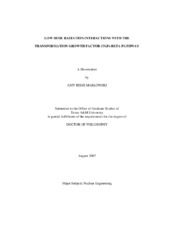| dc.description.abstract | A major limiting factor for long-term, deep-space missions is the radiation dose to
astronauts. Because the dose to the astronauts is a mixed field of low- and high-LET
radiation, there is a need to understand the effects of both radiation types on whole
tissue; however, there are limited published data on the effects of high-LET (linearenergy-
transfer) radiation on tissue. Thus, we designed a perfusion chamber system for
rat trachea in order to mimic in vivo respiratory tissue. We successfully maintained the
perfused tracheal tissue ex vivo in a healthy and viable condition for up to three days. In
addition, this project studied the effects of high-LET Fe particles on the overall
transformation growth factor (TGF)-beta response after TGF-beta inactivation and
compared the results to the TGF-beta response post x-ray irradiation. It was found that a
TGF-beta response could be measured in the perfused tracheal tissue, for x-ray and Fe
particle irradiations, despite the high autofluorescent background intrinsic to tissue.
However, after comparing the TGF-beta response of x-ray irradiation to High-Z-Highenergy
(HZE) irradiation, there was not a significant difference in radiation types. The
TGF-beta response in x-ray and HZE irradiated perfusion chambers was also measured
over time post irradiation. It was found that for 6 hour and 8 hour post irradiation, the TGF-beta response was higher for lower doses of radiation than for higher doses. This is
in contrast to the 0 hour fixation which found the TGF-beta response to increase with
increased dose. The inverse relationship found for 6 hour and 8 hour fixation times may
indicate a threshold response for TGF-beta response; i.e., for low doses, a threshold of
dose must be reached for an immediate TGF-beta response, otherwise the tissue
responds more slowly to the irradiation damage. This result was unexpected and will
require further investigation to determine if the threshold can be determined for the 250
kVp x-rays and 1 Gev Fe particles. | en |


